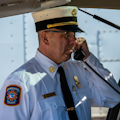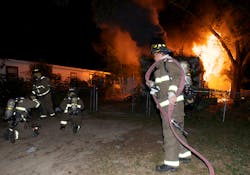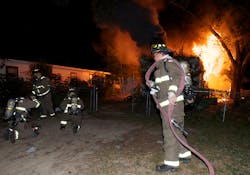Command & Control Success: Water on the Fire
Water application by firefighters is the foundation of firefighting. The American fire service has used water as the primary extinguishing agent since the beginning of bucket brigades, such as Benjamin Franklin’s Union Fire Company in Philadelphia in 1736. In those times, the primary mission of the brigades focused on water application to stop property loss and to control the spread of fire. (Most of the fires that they fought didn’t have people trapped or in jeopardy of getting hurt.)
Water continues to stop property loss, but we always must remember our foundational tactics as we move forward with advanced ways of applying water. In our modern fire environment, water is the equalizer on the field of battle. Firefighters win by creating and maintaining survivable space. When the necessary amount of water is applied promptly, it increases the opportunities for civilians to live another day. When viewed as a primary fireground strategy, water on the fire continues to be the strategy that saves the most civilian and firefighter lives.
Staffing to move water
Bucket brigades succeeded based on the number of available firefighters, the size of the buckets, and the time that it took to refill the buckets and return to the fire. The buckets allowed firefighters to apply water directly onto burning solid fuels. Firefighters of that era had to be aggressive and move with purpose to overcome tactical limitations and to maximize their water application rates.
In our modern firefighting environment, staffing is equally vital, so we have enough firefighters to exceed the application rate that’s needed for the fire potential. Even with the advances in attack packages, staffing still is critical on the fireground to have command success in getting water on the fire.
In “Firefighting Principles & Practices,” Chief William Clark covers staffing at one firefighter per 50 gpm fire flow.NFPA 1710: Standard for the Organization and Deployment of Fire Suppression Operations, Emergency Medical Operations, and Special Operations to the Public by Career Fire Departments suggests fireground staffing of 16 or 17 firefighters when an aerial device operates on residential fires. Together, Clark and NFPA 1710 provide a fire flow of 800–850 gpm. That fire flow is a valid, present-day starting point for staffing to get water on the fire and to complete the other tactics that are necessary to achieve a coordinated fire attack in a typical 2,000-sq.-ft., two-story, single-family dwelling that lacks a basement and exposures. Beyond these smaller structures, the NFPA staffing and response standard significantly increases to 42–43 firefighters when the building has a fire pump for high-rise fires. The other types of buildings to which we commonly respond are sized in between single-family residential and high-rise. Comparing the staffing needs of both gives you a good base for where to start to determine the response staffing for other occupancies where fires are encountered.Science & data influences
We have more information than we ever have to assist in developing solid response models and tactical guidelines to address today’s fire challenges.
UL’s Fire Safety Research Institute (FSRI) is a phenomenal starting point. The organization’s studies regarding exterior fire attack, interior attack, coordinated fire attack, and residential search and rescue reinforce the importance of the timely placement of water on the fire, including in regard to stopping the production of lethal fire gases that will kill trapped occupants. Timely placement of water increases survivability for an occupant and for a trapped firefighter who has a limited air supply.
Today’s fires produce the most toxic smoke ever, and that smoke creates a severe visibility issue inside of the building. These same studies give the fire service solid scientific research from real building fires in acquired structures, utilizing real household furnishings.
The findings also help the fire service advance in getting the right amount of water on the fire from the best location. New training props, such as the FSRI Hose Stream Prop, are only the beginning of getting the fire service more advanced in applying a coordinated fire attack for tomorrow’s fires.
Everyday firefighters also are essential players in data collection to influence modern fireground practices. For example, Chief Brian Brush developed the peer-reviewed “Firefighter Rescue Survey” with data from firefighters who document their wins. Together, we can achieve a better fire attack that will take us leaps and bounds toward reducing civilian and firefighter deaths. We combine the benefits and findings from FSRI’s Hose Stream Prop, the UL search study and facts from the Firefighter Rescue Survey on victim location to achieve our goal.
In previous columns, I covered the importance of taking a calculated risk, the importance of strong tactics for putting out fires, and the value of a deep bench in regard to solidly trained firefighters who understand strong tactics and the need to execute them properly in the shortest period of time. All of these topics, combined with a fire service that embraces the importance of when and where to initiate targeted searches, will achieve command success in getting below 2,000 civilian fire fatalities, which should be a priority for all firefighters and senior staff in the fire service.
Attack package
Departments must build a solid foundational attack package to achieve the most efficient and rapid-fire attack. In doing so, an agency can maximize the NFPA 1710 standard and make the most of the findings from the FSRI studies and the Firefighter Rescue Survey. The Big Four to produce a quality fire stream are a pump, water, hose and a nozzle. All of these are equally important.
Pump and onboard water supply. Historically, fire departments have put some time into selecting a specific type and size of pump over choosing the size of their water supply tank, commonly referred to as a booster tank.
The pump is an essential component of the engine company, and most pumps are specified at 1,000 gpm or more. Still, data from the National Fire Incident Reporting System show that more than 90 percent of all of the fires that occur in the United States are extinguished with one attack line or less. This equates to a rather large safety margin.
The booster tank water supply, aka fast water, also is essential. Most urban departments specify 500 gallons; suburban departments specify 750 gallons; some departments specify 1,000 gallons or more.
FSRI’s study on coordinated fire attack showed that in 25 burns in acquired structures (residential and multifamily), all 25 only required a maximum of 225 gallons of water to be controlled. This backs the capability of a fire apparatus water tank/booster tank to supply 500 gallons or more. That leaves more than 50 percent of a 500-gallon tank as a safety reserve, to provide time for additional water from a second-arriving fire apparatus that has a booster tank and/or a supply line from a fire hydrant to provide a sustained supply. Water supply from a tank and/or a fire hydrant is critical, but it’s more crucial to maximize the water that’s applied at fires.
Getting water properly mapped on the solid burning fuels to stop fire growth quickly and starting ventilation allow firefighters to rapidly locate trapped occupants, stopping any void-space fires through the ability to see and open up. This also makes the interior safer for firefighters should a mishap occur.
The pump size and tank size are essential to achieve the above results of rapid-fire control to achieve command success but so is the work regarding selection of the hoseline and nozzle to complement the pump and booster tank. The hose and nozzle are the second half of the Big Four.
Hose and nozzle. Historically, it has been common for departments to purchase an array of nozzle types and hook them to the end of any hoseline. More than ever, it’s crucial that departments perform a full weapon selection and attack package evaluation to determine what type(s) of nozzles they need based on their fire challenges. Nozzles must complement the hoses to which they are attached. The greatest nozzle ever will produce less than desirable results if it isn’t married properly to a hoseline that’s designed for the flow rate and nozzle pressure design.
There has been a long-standing debate on whether fog or straight/solid stream attacks are more efficient for fire control. The debate is basically over: Straight/solid streams that are applied directly to burning solid fuels produce the best results with the least amount of water. They also maintain a safer environment for trapped civilians and firefighters.
Using 150 gpm as the residential standard fire flow as a starting point, departments first must do a flow test with their current hose and nozzles based on the pump discharge pressure that’s used most commonly at house fires. This requires a pitot gauge and a flow meter to get an absolute number of what is flowing. Based on hose creep and so many different sizes and brands of attack hose, more times than not, a friction loss sheet doesn’t indicate accurately what is flowing. Each truck that’s equipped with a pump has a certain amount of friction loss based on how the manufacturer plumbed it, and then the friction loss varies based on the brand and model. Further, some hose that’s labeled 1.75 inches actually is 1.88 inches, and some hose that’s labeled 2.5 inches is larger, to give the hose manufacturer the capability to advertise as having lower friction loss than a competitor.
Departments must select hose based on the desired flow, nozzle type and designed nozzle pressure for the selected nozzle type. Some fixed-gallonage low-pressure nozzles can be 50 psi or 75 psi. I frequently observed severe kinking and nozzle whip, as some refer to it, when a 50-psi nozzle was utilized, but the issue resolves when attaching and flowing a 75-psi nozzle. I also observed many times at fire conferences where a 15/16-in. smooth bore nozzle operating at 50 psi caused kinking issues, but when it was replaced with a 7/8-in., which reduced the flow rate to 165 from 185, the problems were resolved.
The fire service also must start to evaluate the use of smooth bore tips flowing a range of flows based on pumping below or above the 50 psi that’s taught as the pressure that’s used for a handheld smooth bore tip. The same can be said for overpumping or underpumping a master stream smooth bore tip that historically has been taught as 80 psi. Flow matters, but the desired nozzle reaction/combat mobility and the desired stream reach are equally as important to complete a quality attack package that will set up a department for success at most of its fires.
About the Author

Curt Isakson
Curt “Ike” Isakson is a 30-plus-year veteran of the fire service. He worked for Escambia County, FL, Fire Rescue for 25 years. Isakson previously worked nine years for the Pensacola, FL, Fire Department, where he was assigned as a company officer on Heavy Rescue 31. His fire service experience started at a young age as a junior firefighter with the Midway, FL, Fire District; he rose through the ranks to captain. Isakson's identification of the need for a series of special-interest fire conferences spawned the development of County Fire Tactics, which covers officer development, command officers, water on fire, high-rise operations, and leadership and tactics.

